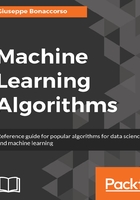
Atom extraction and dictionary learning
Dictionary learning is a technique which allows rebuilding a sample starting from a sparse dictionary of atoms (similar to principal components). In Mairal J., Bach F., Ponce J., Sapiro G., Online Dictionary Learning for Sparse Coding, Proceedings of the 29th International Conference on Machine Learning, 2009 there's a description of the same online strategy adopted by scikit-learn, which can be summarized as a double optimization problem where:
Is an input dataset and the target is to find both a dictionary D and a set of weights for each sample:
After the training process, an input vector can be computed as:
The optimization problem (which involves both D and alpha vectors) can be expressed as the minimization of the following loss function:
Here the parameter c controls the level of sparsity (which is proportional to the strength of L1 normalization). This problem can be solved by alternating the least square variable until a stable point is reached.
In scikit-learn, we can implement such an algorithm with the class DictionaryLearning (using the usual MNIST datasets), where n_components, as usual, determines the number of atoms:
from sklearn.decomposition import DictionaryLearning
>>> dl = DictionaryLearning(n_components=36, fit_algorithm='lars', transform_algorithm='lasso_lars')
>>> X_dict = dl.fit_transform(digits.data)
A plot of each atom (component) is shown in the following figure:
